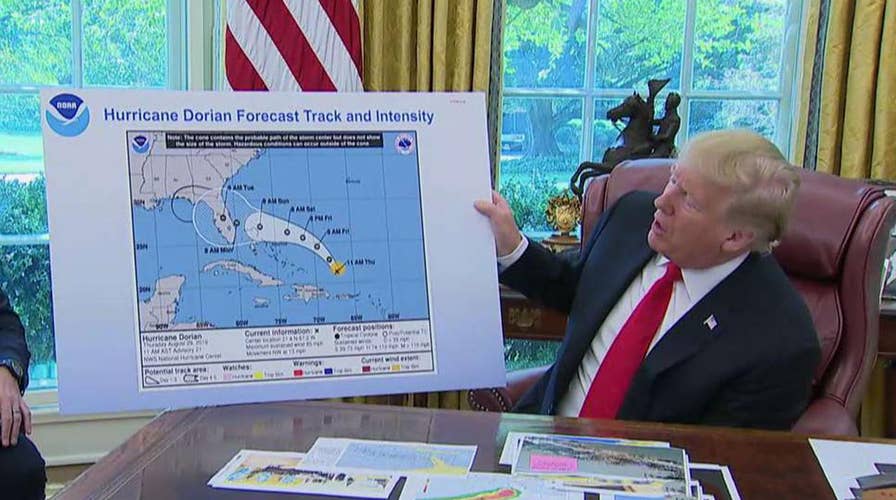Media jumps on President Trump for showing altered Dorian forecast map
A White House official says an unidentified person added the squiggle as Trump met with his emergency team; Fox News media analyst Howard Kurtz reports.
The federal agency that monitors hurricanes said Friday that Hurricane Dorian could have impacted Alabama, backing claims by President Trump that he was right to tweet a warning over the weekend about the storm affecting the state.
In an unsigned statement, the National Oceanic and Atmospheric Administration (NOAA) said that "information provided by NOAA and the National Hurricane Center to President Trump and the wider public demonstrated that tropical-storm-force winds from Hurricane Dorian could impact Alabama." The advisories in question were dated from Wednesday, Aug. 28 to Monday, Sept. 2, the agency said.
TRUMP DOUBLES DOWN ON CLAIM DORIAN THREATENED ALABAMA, SLAMS MEDIA MOCKERY
The statement points to a few graphics issued by the National Hurricane Center to support Trump's claims. The maps show percentage possibility of tropical storm force winds in the United States. Parts of Alabama were covered, usually with 5 percent to 10 percent chances, between Aug. 27 and Sept. 3. Maps on Aug. 30 grew to cover far more of Alabama, but for only 12 hours, and the highest percentage hit 20 percent to 30 percent before quickly shrinking back down.
The controversy began Sunday morning when Trump tweeted that Florida, "South Carolina, North Carolina, Georgia, and Alabama, will most likely be hit [much] harder than anticipated" by Dorian. In response, the National Weather Service's Birmingham office tweeted that Alabama “will NOT see any impacts from Dorian.”
“We repeat, no impacts from Hurricane Dorian will be felt across Alabama. The system will remain too far east," the office said in response to Trump's comments.
But on Friday, NOAA said that the NWS tweet "spoke in absolute terms that were inconsistent with probabilities from the best forecast products available at the time."
The statement from NOAA contrasts with comments the agency's spokesman, Chris Vaccaro, made Sunday. "The current forecast path of Dorian does not include Alabama," Vaccaro said at the time.
Dan Sobien, president of the union representing weather service employees, tweeted Friday, "Let me assure you the hard working employees of the NWS had nothing to do with the utterly disgusting and disingenuous tweet sent out by NOAA management tonight."
Other meteorologists also voiced concerns about NOAA's actions Friday. University of Georgia meteorology professor Marshall Shepherd, former president of the American Meteorology Society, simply responded, "OMG."
"I am very disappointed to see this statement come out from NOAA," Oklahoma University meteorology professor Jason Furtado told The Associated Press. "I am thankful for the folks at NWS Birmingham for their work in keeping the citizens of Alabama informed and up to date on weather hazards."
Furtado said NOAA's statement and the president's Twitter "war on weather" are undermining confidence in meteorologists, adding, "The job just got harder because of this issue."
Trump has defended his comments repeatedly this week, insisting that the information he gave Sunday was accurate. On Wednesday, the president held up a map in the Oval Office showing the “cone of uncertainty” over areas possibly affected by the storm. A part of Alabama appeared to be circled in black marker.
TRUMP INSISTS ALABAMA WAS THREATENED BY DORIAN, SHARES FORECAST MODEL
The media criticized the president over his claims, causing Trump to say Thursday that the coverage was meant to “demean” him, adding, “What I said was accurate!” He posted images of NOAA graphics that at one point projected Dorian’s possible impact on Alabama.
On Thursday afternoon, Trump invited Fox News into the Oval Office to emphasize his point that forecasts for Dorian last week had Alabama in the warning cone, providing a graphic from the National Hurricane Center and a screenshot of a news report on NBC.
Fox News was also told that Trump was shown a graphic prior to a briefing by the Federal Emergency Management Agency (FEMA) last week that appeared to show an older forecast track with Dorian going north through the Florida peninsula and just grazing Alabama.
When asked why his Sunday morning tweet mentioning Alabama came after the forecast track had moved much farther east, the president seemed to agree that the forecast track had moved but was adamant that at some point, Alabama had been at risk. He also emphasized that on occasions in the past, forecast tracks have changed dramatically.
CLICK HERE TO GET THE FOX NEWS APP
Also Thursday, the White House released a statement from Rear Adm. Peter J. Brown, the president’s homeland security and counterterrorism adviser, who said he briefed the president on Sunday about the storm, including “possible storm impacts well outside the official forecast cone.”
“The president’s comments were based on that morning’s Hurricane Dorian briefing, which included the possibility of tropical storm-force winds in southeastern Alabama,” Brown said.
On Friday, Trump tweeted: “The Fake News Media was fixated on the fact that I properly said, at the beginnings of Hurricane Dorian, that in addition to Florida & other states, Alabama may also be grazed or hit. They went Crazy, hoping against hope that I made a mistake (which I didn’t). Check out maps.....”
He followed up hours later by tweeting: "Just as I said, Alabama was originally projected to be hit. The Fake News denies it!"
Fox News’ Brooke Singman, John Roberts and Alex Pappas contributed to this report, along with the Associated Press.






















